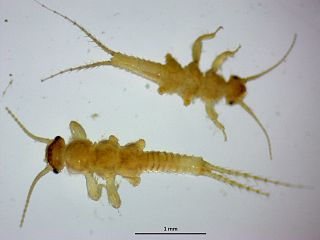
The Plecoptera are an order of insects, commonly known as stoneflies. Some 3,500 species are described worldwide, with new species still being discovered. Stoneflies are found worldwide, except Antarctica. Stoneflies are believed to be one of the most primitive groups of Neoptera, with close relatives identified from the Carboniferous and Lower Permian geological periods, while true stoneflies are known from fossils only a bit younger. Their modern diversity, however, apparently is of Mesozoic origin.

The Nemouridae are a family of stoneflies containing more than 700 described species, occurring primarily in the Holarctic region. Members of this family are commonly known as spring stoneflies or brown stoneflies. Fly fishermen often refer to these insects as tiny winter blacks.

Soyedina is a genus of stoneflies belonging to the family Nemouridae. This exclusively Nearctic genus was originally erected as a subgenus of Nemoura but was elevated to genus status by Joachim Illies in 1966. There are currently 11 described species, most only identifiable by small differences in the genitalia.
Ostrocerca truncata, the truncate forestfly, is a species of spring stonefly in the family Nemouridae. It is found in North America.
Zapada columbiana is a species in the family Nemouridae, in the order Plecoptera ("stoneflies"). The species is known generally as the "Columbian forestfly". It is found in North America.
Zapada is a genus of spring stoneflies in the family Nemouridae. There are at least 10 described species in Zapada.
Nemourinae is a subfamily of stoneflies in the family Nemouridae. There are at least 40 described species in Nemourinae.
Amphinemura linda is a species of spring stonefly in the family Nemouridae. It is found in North America.

Amphinemura is a genus of spring stoneflies in the family Nemouridae. There are about 18 described species in Amphinemura.
Ostrocerca is a genus of spring stoneflies in the family Nemouridae. There are about six described species in Ostrocerca.
Zapada cinctipes, the common forestfly, is a species of spring stonefly in the family Nemouridae. It is found in North America.
Ostrocerca dimicki, the hooked forestfly, is a species of spring stonefly in the family Nemouridae. It is found in North America.
Shipsa is a genus of spring stoneflies in the family Nemouridae. There is one described species in Shipsa, S. rotunda.
Nemoura arctica is a species of spring stonefly in the family Nemouridae. It is found in North America, temperate Asia, and Europe.

Nemoura is a genus of spring stoneflies in the family Nemouridae. There are more than 190 described species in Nemoura.
Amphinemura nigritta, the little black forestfly, is a species of spring stonefly in the family Nemouridae. It is found in North America.
Prostoia similis, the longhorn forestfly, is a species of spring stonefly in the family Nemouridae. It is found in North America.
Podmosta is a genus of spring stoneflies in the family Nemouridae. There are about six described species in Podmosta.
Nadata oregonensis is a species of moth in the family Notodontidae. It was first described by Arthur Gardiner Butler in 1881 and it is found in North America.
Paranemoura is a genus of spring stoneflies in the family Nemouridae. There are at least two described species in Paranemoura.




